Serviços Personalizados
Artigo
Links relacionados
Compartilhar
Stomatos
versão impressa ISSN 1519-4442
Stomatos vol.22 no.42 Canoas Jan./Jun. 2016
Masking ability of different ceramic systems over a darkened substrate
Capacidade de mascaramento de diferentes sistemas cerâmicos sobre um substrato escurecido
Manuel Tomás B. Radaelli I; Leonardo Federizzi II; Fabíola Jardim Barbon III; Aloísio O. Spazzin IV; Noeli Boscato V
I DDS and PhD student at Graduate Program in Dentistry, Universidade Federal de Pelotas (UFPel), Pelotas, RS, Brazil, and professor at Department of Prosthodontics, Centro de Estudos Odontológicos Meridional (CEOM), Passo Fundo, RS, Brazil
II DDS, MSc, and professor at the Department of Prosthodontics, CEOM, Passo Fundo, RS, Brazil
III DDS and MSc student at Graduate Program in Dentistry, UFPel, Pelotas, RS, Brazil
IV DDS, MSc, PhD, and professor at the Department of Prosthodontics, CEOM, Passo Fundo, RS, Brazil
V DDS, MSc, PhD, and professor at Graduate Program in Dentistry, UFPel, Pelotas, RS, Brazil
The authors have no conflicts of interest to declare concerning the publication of this manuscript.
ABSTRACT
This clinical report describes the masking ability of IPS e.max ceramic (lithium disilicate glass-ceramic and polycrystalline zirconia) used over darkened (metallic post) and natural-colored backgrounds. Initially, medium-opacity lithium disilicate glass-ceramic framework (IPS e.max Press MO) was used over both backgrounds. It was observed that at the minimum thickness recommended by the manufacturer, the medium-opacity lithium disilicate glass-ceramic framework did not provide sufficient masking ability over the darkened background (metallic post). Then, because of its inadequate masking ability, the lithium disilicate glass-ceramic framework over the metallic post was replaced with polycrystalline zirconia (IPS e.max ZirCAD). It was concluded that using polycrystalline zirconia resulted in better masking ability and superior final aesthetic appearance over a darkened background.
Keywords: Ceramic; Translucency; Metallic post; Color; Crown.
RESUMO
Esse relato de caso descreve a capacidade de mascaramento da cerâmica IPS e.max (dissilicato de lítio, vitrocerâmica, e zircônia, policristalina) usadas sobre substrato escurecido (pino metálico) e com coloração normal. Inicialmente, a infraestrutura de dissilicato de lítio com opacidade intermediária (IPS e.max Press MO) foi usada sobre os dois diferentes substratos. Foi observado que, na mínima espessura recomendada pelo fabricante, o dissilicato de lítio com opacidade intermediária não forneceu capacidade de mascaramento suficiente sobre o substrato escurecido (pino metálico). Então, sobre o pino metálico, a infraestrutura confeccionada à base de dissilicato de lítio foi substituída por zircônia (IPS e.max ZirCAD). Foi possível concluir que o uso da infraestrutura de zircônia policristalina mostrou melhor capacidade de mascaramento e aparência estética final sobre fundos escurecidos.
Palavras-chave: Cerâmica; Traslucidez; Pino metálico; Cor; Coroa.
INTRODUCTION
The ability of ceramics to match the natural dentition and their appropriate physical and optical properties have made this material the first choice for aesthetic restorations1-3. However, previous procedures such as endodontic treatments4,5 or insertion of metallic posts (5) may result in darkened substrates, affecting the final color and jeopardizing the aesthetic appearance of all-ceramic restorations.
The translucency of ceramics has been emphasized as a primary factor in achieving adequate aesthetic outcomes1. Nonetheless, although glass-ceramic offers adequate optical properties, it is sometimes unable to mask darkened substrates because of its translucency3,6-8. In these situations, all-ceramic systems with greater opacity and crystalline phase content should be used, since they provide greater masking ability2,7,9-11.
Several different ceramic systems, designed to improve the final appearance of definitive all-ceramic restorations, have been described in the literature. However, it is a challenge for clinicians to select a ceramic system with the ability to mask the underlying substrate and match the appearance of ceramic restorations with patients' natural teeth, irrespective of differences in substrate color12. This clinical report describes the masking ability of IPS e.max ceramic (lithium disilicate glass-ceramic and polycrystalline zirconia) over darkened (metallic post) and natural-colored backgrounds.
CASE REPORT
This clinical report was approved by the Institutional Review Board at the School of Dentistry, Universidade Federal de Pelotas, Brazil (protocol no. 905.099/2015).
A 35-year-old woman sought dental care complaining that she was unhappy with the aesthetic appearance of her smile. Intraoral clinical examination revealed interim acrylic resin crowns with poor color matching on maxillary right and left central incisors (Figure 1). Radiographic images showed healthy periodontal support and the right central incisor had previously undergone endodontic treatment and post placement with satisfactory results. Removal of the interim crowns revealed a natural-colored background on the left maxillary central incisor and a darkened background (caused by the metallic post) on the right maxillary central incisor. The teeth were re-prepared to receive metal-free crowns using diamond burs and a chamfer finish line was created, observing the minimum thickness recommended by the manufacturer. Cervical preparation was extended to the cementoenamel junction and smooth margins were created to prevent stress concentration zones (Figure 2). New interim restorations were made using prefabricated acrylic resin teeth (Trilux; VIPI Produtos Odontológicos, Pirassununga, São Paulo, SP, Brazil) and self-cured acrylic resin (Dencôr; Clássico, Campo Limpo Paulista, SP, Brazil), providing both function and aesthetics.

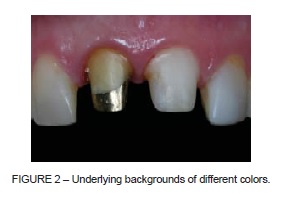
One month later, the patient returned for the impression step. The soft tissue was displaced using the double cord technique (#000 and #0 Ultrapak cord; Ultradent, Idaiatuba, SP, Brazil) (Figures 3A and 3B), and a full-arch impression was performed with polyvinyl siloxane (Express XT Putty and Light Body; 3M Espe, St. Paul, MN, USA) using a double-mix technique. An opposing arch impression was also taken using irreversible hydrocolloid (Cavex ColorChange; Cavex, Haalen, Netherlands). Color selection was conducted using digital images and a shade guide (Vitapan Classic; Vita-Zahnfabrik, Bad Sackingen, Germany). The left central incisor matched shade B2 (cervical) and B1 (incisal edge), and the right central incisor matched shade B4 (Figures 4A and 4B).
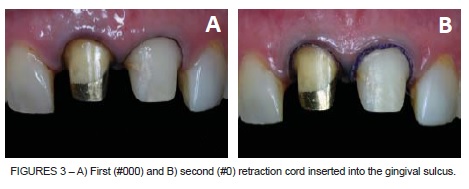
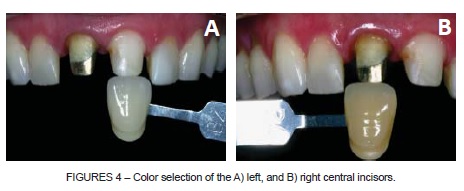
Stone casts and an interocclusal record at maximum intercuspation position were obtained. After the stone casts had been mounted in a semi-adjustable articulator (A7Fix; Bioart, Jardim Tangará, São Carlos, SP, Brazil), they were sent to the laboratory along with photos for manufacture of the ceramic frameworks. A wax pattern was prepared and pressed using medium-opacity lithium disilicate ingots (IPS e.max Press MO1; Ivoclar Vivadent,Tamboré, Barueri, SP, Brazil) for both crowns, to obtain copings with the minimum thickness recommended by the manufacturer. After verifying the fit of the copings, the veneer porcelain (IPS e.max Ceram; Ivoclar Vivadent, Tamboré, Barueri, SP, Brazil) was applied and fired to achieve the definitive dental shape. Aesthetic, phonetic, and functional evaluations were performed clinically.
At this point, it was observed that the medium-opacity lithium disilicate framework did not mask the metallic post inserted in the right central incisor. Frontal view photos (Figures 5A and 5B) with gamma correction, color supersaturation, and grayscale transformation (Figures 6A to 6F) were taken using a digital single lens refl ex camera (Canon EOS Rebel T5i, Tokyo, Japan) to enable visualization of color discrepancies between the ceramic crowns. The decision was then taken to keep the left ceramic crown and make a new one for the right tooth using a more opaque framework, made of polycrystalline zirconia (IPS e.max ZirCAD; Ivoclar Vivadent, Tamboré, Barueri, SP, Brazil). The same stone casts and photographs were once more sent to the laboratory for fabrication of the new crown. After evaluation of aesthetic and functional aspects, the crowns were cemented using light-cured resin cement (RelyXTMVenner, 3M Espe, St Paul, MN, USA) shade A1, following the manufacturer's instructions for each type of ceramic material. Photopolymerization was performed using a light emitting diode device (Radii-cal; SDI Brasil LTDA, Bayswater, Victoria, Australia) for 40 seconds at each face. All excess cement was removed from the marginal area. Figure 7 shows the crowns 1 month after cementing.
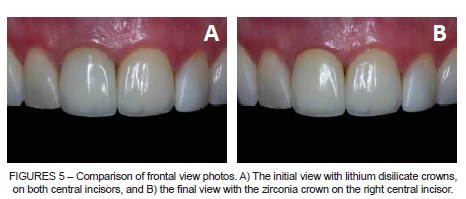
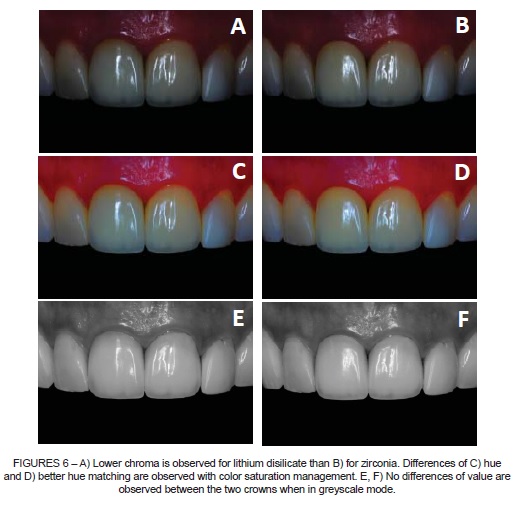
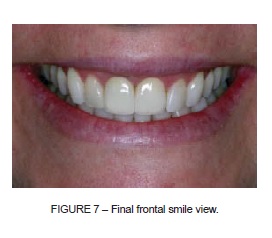
DISCUSSION
The ideal choice of ceramic opacity is a crucial element in obtaining clinically acceptable color-matching between crowns fitted over different substrates, since the opacity of the ceramic system can infl uence the final color of the restorations1,3,12. The aesthetic appearance obtained in this clinical report revealed that a medium-opacity lithium disilicate crown did not mask an underlying darkened background caused by a metallic post. When the lithium disilicate framework was changed for polycrystalline zirconia, it was observed that the replacement material exhibited a better capacity for masking the metallic post.
Translucent ceramic systems allow light to be reflected and scattered from the underlying background, thereby affecting the final color of restorations13. As a result, translucent restorations can very closely mimic natural teeth, but in such situations, the elements to be restored usually present fewer color changes requiring correction. When more significant color changes are required, the opacity and thickness of the ceramic system should be carefully adjusted, because darkened substrates such as metallic posts can lead to undesirable changes to the final color of glass-ceramic restorations5,6. In these situations, more opaque ceramic systems should be used to achieve adequate masking9,11,13,14.
Since the opacity of ceramics is affected by the optical properties, microstructure, and thickness of ceramic systems13-17, several in vitro studies have been conducted to investigate these issues to improve understanding of their capacity to mask unsatisfactory background shades3,5,6,11,18-21.
In these in vitro studies, increased ceramic thickness and opacity have been linked to better masking ability of all-ceramic restorations over darkened substrates such as metallic posts3,5,6,16,18. In this clinical report, the restorations observed the minimum thicknesses recommended by the manufacturer (0.5 mm for polycrystalline zirconia and 0.8 mm for the lithium disilicate framework). Additionally, the final thicknesses of the two restorations were different, because it is necessary to provide more space for veneering porcelain stratification in the presence of darkened substrates. Therefore, the left and right central incisor restorations have final vestibular surface thicknesses of 1.2 mm and 1.8 mm respectively.
The amount of light absorbed, reflected, and transmitted by dental porcelain depends on the crystal content, chemical nature, and size of the particles compared to the wavelength of the incident light2. The crystal content of the lithium disilicate glass-ceramic is greater than 60% by volume, and the index of refraction of the crystal phase is adjusted to that of the glass matrix to control the translucency of the material. As a result, this material can be produced to different levels of translucency, depending on clinical requirements22. However, because it is considered a translucent ceramic,2,9,10,23, if there is insufficient material thickness, the color of a darkened substrate will negatively infl uence the aesthetic result of the prosthetic restorative treatment3,6-8. On the other hand, with a crystal content of 99% by volume and a higher refractive index, polycrystalline zirconia frameworks intercept incident light more efficiently than lithium disilicate frameworks and nullify the influence of underlying structures on the light refl ected to the observer, so they are considered opaque ceramics2,24. Therefore, restorations manufactured with this material exhibit greater masking ability, which can be very useful in aesthetically demanding clinical situations, such as masking discolored substrates or metallic posts2,7,9-11.
The IPS e.max ceramic system is an all-ceramic system that uses both lithium disilicate glass-ceramic and polycrystalline zirconia as framework. In this clinical report, the lithium disilicate framework was chosen because of the superior aesthetic properties of this ceramic when compared to polycrystalline zirconia ceramics. According to the manufacturer's table for ingot shade selection25, if a B1 final shade is desired then the medium-opaque (MO 1) or high-opaque (HO 1) ingot should be used to mask darkened substrates with a B4 or yellowish metal shade color. In the treatment described here, the MO 1 ingot was used to make both frameworks because the left substrate had a natural color and it was preferable to refl ect this naturalness. However, even observing the manufacturer's instructions and leaving more space to stratify the veneering porcelain over the right coping, this option proved inadequate and a grayish discoloration was noted when both crowns were compared during clinical assessment. The manufacture of one new restoration with polycrystalline zirconia framework at the minimum thickness recommended by the manufacturer was sufficient to solve this problem, providing excellent color matching between both restorations, as can be observed in the images with digital adjustments.
It is probable that a high opacity ingot of lithium disilicate could completely mask the darkened substrate. However, the masking ability of polycrystalline zirconia is greater, due to the refractive index, and the manufacturer's recommendation for minimum framework thickness is lower, because of its higher compressive strength. The quantity of color discrepancies adjusted with the veneering porcelain over the polycrystalline zirconia coping is smaller, and the space available for stratification is greater. Additionally, the shade of the zirconia blocks in this system is based on that of medium opacity lithium disilicate glass-ceramic ingots, making it even easier to achieve the same final color as the adjacent restoration that was manufactured with the lithium disilicate MO framework.
FINAL CONSIDERATION
At the minimum thickness recommended by the manufacturer, the medium opacity lithium disilicate glass-ceramic framework did not provide sufficient masking ability over a darkened background (metallic post). The opacity of the polycrystalline zirconia framework affected the final appearance of the restoration over the metallic post.
REFERENCES
1. Kelly JR, Nishimura I, Campbell SD. Ceramics in dentistry: historical roots and current perspectives. J Prosthet Dent. 1996;75:18-32. [ Links ]
2. Heffernan MJ, Aquilino SA, Diaz-Arnold AM, Haselton DR, Stanford CM, Vargas MA. Relative translucency of six all-ceramic systems. Part I: Core Materials. J Prosthet Dent. 2002;88:4-9.
3. Chaiyabutr Y, Kois JC, Lebeau D, Nunokawa G. Effect of abutment tooth color, cement color, and ceramic thickness on the resulting optical color of a CAD/CAM glass-ceramic lithium disilicate-reinforced crown. J Prosthet Dent. 2011;105:83-90.
4. Krastl G, Allgayer N, Lenherr P, Filippi A, Taneja P, Weiger R. Tooth discoloration induced by endodontic materials: a literature review. Dent Traumatol. 2013;29:2-7.
5. Nakamura T, Saito O, Fuyikawa J, Ishigaki S. Infl uence of abutment substrate and ceramic thickness on the colour of heat-pressed ceramic crowns. J Oral Rehabil. 2002;29:805-9.
6. Shimada K, Nakazawa M, Kakehashi Y, Matsumura H. Infl uence of abutment materials on the resultant color of heat-pressed lithium disilicate ceramics. Dent Mater J. 2006;25:20-5.
7. Chang J, Da Silva JD, Sakai M, Kristiansen J, Ishikawa-Nagai S. The optical effect of composite luting cement on all ceramic crowns. J Dent. 2009;37:937-43.
8. de Azevedo Cubas GB, Camacho GB, Demarco FF, Pereira-Cenci T. The effect of luting agents and ceramic thickness on the color variation of different ceramics against a chromatic background. Eur J Dent. 2011;5:245-52.
9. Chen YM, Smales RJ, Yip KH, Sung WJ. Translucency and biaxial fl exural strength of four ceramic core materials. Dent Mater. 2008;24:1506-11.
10. Lim HN, Yu B, Lee YK. Spectroradiometric and spectrophotometric translucency of ceramic materials. J Prosthet Dent. 2010;104:239-46.
11. Alghazzawi TF, Lemons J, Liu PR, Essig ME, Janowski GM. Evaluation of the optical properties of CAD-CAM generated yttria-stabilized zirconia and glass-ceramic laminate veneers. J Prosthet Dent. 2012;107:300-8.
12. Terzioğlu H, Yilmaz B, Yurdukoru B. The effect of different shades of specific luting agents and IPS empress ceramic thickness on overall color. Int J Periodontics Restorative Dent. 2009;29:499-505.
13. Antonson SA, Anusavice KJ. Contrast ratio of veneering and core ceramics as a function of thickness. Int J Prosthodont. 2001;14:316-20.
14. Chu FC, Chow TW, Chai J. Contrast ratios and masking ability of three types of ceramic veneers. J Prosthet Dent. 2007;98:359-64.
15. Luo XP, Zhang L. Effect of veneering techniques on color and translucency of Y-TZP. J Prosthodont. 2010;19:465-70.
16. Wang F, Takahashi H, Iwasaki N. Translucency of dental ceramics with different thicknesses. J Prosthet Dent. 2013;110:14-20.
17. Heffernan MJ, Aquilino SA, Diaz-Arnold AM, Haselton DR, Stanford CM, Vargas MA. Relative translucency of six all-ceramic systems. Part II: core and veneer materials. J Prosthet Dent. 2002;88:10-5.
18. Vichi A, Ferrari M, Davidson CL. Infl uence of ceramic and cement thickness on the masking of various types of opaque posts. J Prosthet Dent. 2000;83:412-7.
19. Azer SS, Rosenstiel SF, Seghi RR, Johnston WM. Effect of substrate shades on the color of ceramic laminate veneers. J Prosthet Dent. 2011;106:179-83.
20. Jalali H, Alizadeh ES, Sadighpour L, Shabestari GO, Fard MJ. The effect of background and ceramic thickness on the color of an all-ceramic restorative system. J Calif Dent Assoc. 2010;38:179-86.
21. Choi YJ, Razzoog ME. Masking ability of zirconia with and without veneering porcelain. J Prosthodont. 2013;22:98-104.
22. Höland W, Schweiger M, Watzke R, Peschke A, Kappert H. Ceramics as biomaterials for dental restoration. Expert Rev Med Devices. 2008;5:729-45.
23. Spear F, Holloway J. Which all-ceramic system is optimal for anterior esthetics? J Am Dent Assoc. 2008;139Suppl:19S-24S.
24. Vagkopoulou T, Koutayas SO, Koidis P, Strub JR. Zirconia in dentistry: Part 1. Discovering the nature of an upcoming bioceramic. Eur J Esthet Dent. 2009;4:130-51.
25. Vivadent I. IPS e.max® Press – Instructions for use. Schaan/Liechtenstein: Ivoclar Vivadent AG; 2009.
 Correspondence:
Correspondence:
Noéli Boscato
Graduate Program in Dentistry
Universidade Federal de Pelotas
Rua Gonçalves Chaves, 457
CEP 96015-560, Pelotas
RS, Brazil
E-mail: noeliboscato@gmail.com













